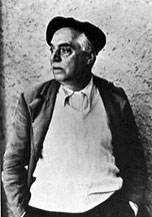
Italian painter, prominent in the Futurist movement, co-creator of Pitlura metafisica and subsequently a tradition-based realist of peat power.
He was trained at the Milan Academy where he met Boccioni.
In 1910 he joined him and others in signing the twro manifestos of Futurist painting.
His personal manifesto of 1913 called for paintings delivering ‘the plastic equivalents of sounds, noises and smells’ of urban life. His first Futurist paintings were street scenes involving the spectator in impersonal dramas. In late 1911 he went with Boccioni and Russolo to Paris to confront Cubism. The work he showed in the 1912 Paris exhibition displays its impact of the group, Carra embraced Cubism most wholeheartedly.
His work changed in 1914 when he gave priority to working with collage and incorporating words in the Futurist exclamatory and onomatopoeic way.
He eagerly served in the Italian army in 1915-16. In an army hospital in Ferrara he met de Chirico and together they launched Pittura metafisica. His early regard for Giotto, Uccello and other Renaissance masters, never quite forgotten, became patent around 1919. Carra now worked in a national idiom rooted in the early Renaissance and in antiquity, and was recognized as a major Italian artist.
He published a number of books: Futurist texts (1915) and books on his life and his art (1945, 1962) among them. Milan commemorated him with a retrospective in 1967-68.
